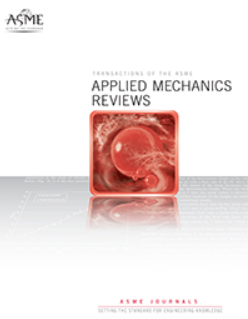用强迫对抗自由振动:第一部分-非共振和带相移的共振强迫
IF 16.1
1区 工程技术
Q1 MECHANICS
引用次数: 0
摘要
问题是连续系统的自由振荡是否可以被抑制,或者至少是总能量的减少,通过施加外力,以均匀弹性弦的线性无阻尼横向振荡为例。与所有固有频率不同,施加频率下的非共振强迫不与能量不变的正模态相互作用,并增加了受迫振荡的能量,从而增加了总能量,这与所寻求的结果相反。当施加频率等于一个固有频率时,共振力导致振幅随时间线性增长,因此能量随时间二次增长,这意味着在足够长的时间后总能量增加。在短时间内,比如在振荡的第一个周期内,通过优化强迫,总能量的减少是可能的。在集中力的情况下,通过优化其大小和位置,在一个周期内的总能量相对于单独的自由振荡减少了2%的适度最大值。对于几种集中力,结论是相似的。在力连续分布的情况下,通过优化空间分布,有可能在振动的第一个周期内将总振荡的能量降低到自由振荡的四分之一。这表明连续分布力比点力更有效地抑制振动。本文章由计算机程序翻译,如有差异,请以英文原文为准。
On the Countering of Free Vibrations by Forcing: Part I—Non-Resonant and Resonant Forcing with Phase Shifts
The question addressed is whether the free oscillations of a continuous system can be suppressed, or at least the total energy reduced, by applying external forces, using as example the linear undamped transverse oscillations of a uniform elastic string. The non-resonant forcing at an applied frequency, distinct from all natural frequencies, does not interact with the normal modes, whose energy is unchanged, and adds the energy of the forced oscillation, thus increasing the total energy, that is the opposite of the result being sought. The resonant forcing at an applied frequency, equal to one of the natural frequencies, leads to an amplitude growing linearly with time, and hence the energy is growing quadratically with time, implying an increase in total energy after a sufficiently long time. A reduction in total energy is possible over a short time, say over the first period of oscillation, by optimizing the forcing. In the case of a concentrated force, by optimizing its magnitude and location, the total energy with forcing in one period is reduced by a modest maximum of 2% relative to the free oscillation alone. The conclusion is similar for several concentrated forces. In the case of a continuously distributed force, by optimizing the spatial distribution, it is possible to reduce the energy of the total oscillation to one-fourth of that of the free oscillation over the first period of vibration. This shows that continuously distributed forces are more effective at vibration suppression than point forces.
求助全文
通过发布文献求助,成功后即可免费获取论文全文。
去求助
来源期刊
CiteScore
28.20
自引率
0.70%
发文量
13
审稿时长
>12 weeks
期刊介绍:
Applied Mechanics Reviews (AMR) is an international review journal that serves as a premier venue for dissemination of material across all subdisciplines of applied mechanics and engineering science, including fluid and solid mechanics, heat transfer, dynamics and vibration, and applications.AMR provides an archival repository for state-of-the-art and retrospective survey articles and reviews of research areas and curricular developments. The journal invites commentary on research and education policy in different countries. The journal also invites original tutorial and educational material in applied mechanics targeting non-specialist audiences, including undergraduate and K-12 students.

 求助内容:
求助内容: 应助结果提醒方式:
应助结果提醒方式:


